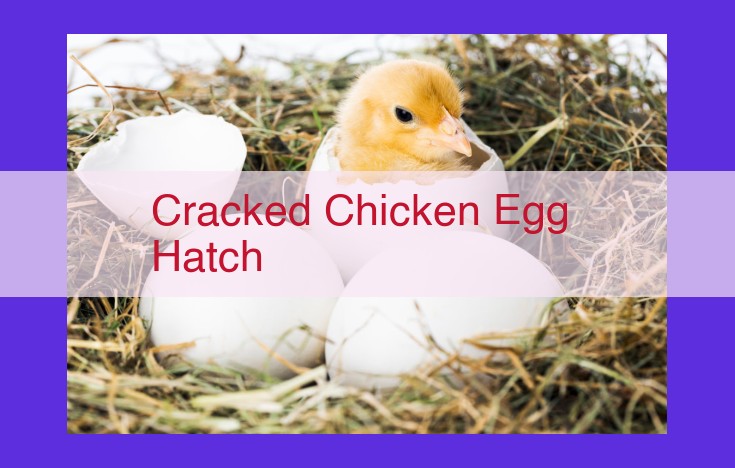Cracked Chicken Egg Hatch: Understanding the Biology of Hatching. This article explores the intriguing process of chicken egg hatching, unraveling the biology behind each step from embryo development within the egg to the emergence of the chick. It elucidates the significance of the eggshell as a protective and nurturing environment, the embryo’s physical and physiological changes, and the sequential events leading to the chick’s successful hatching. Moreover, the article highlights the critical roles of the yolk sac, chorioallantoic membrane, and blood vessel network in supporting embryo growth and the hatching process.
Unlocking the Secrets of Chicken Egg Hatching: A Biological Adventure
In the realm of nature’s wonders, the hatching of a chicken egg stands as a captivating spectacle, a testament to the intricate ballet of life unfolding within its shell. This blog post embarks on a journey into the depths of this extraordinary process, unraveling the biological mechanisms that orchestrate the transformation of a tiny embryo into a lively chick. By delving into the science behind egg hatching, not only will we gain a deeper appreciation for the beauty of nature but also amass invaluable knowledge about the early stages of avian development.
Embarking on the Embryonic Journey
Nestled within the protective confines of the eggshell, the embryonic marvel begins its odyssey. With the commencement of incubation, a symphony of cellular activities unfolds. The embryo, initially a mere cluster of rapidly dividing cells, embarks on an extraordinary journey of metamorphosis. As days turn into nights, the embryo gradually takes form, acquiring the intricate structures that will ultimately define the chick to come.
The Nurturing Embrace of the Egg’s Interior
Within the egg’s interior, an intricate microcosm unfolds, providing the embryo with the sustenance and protection it needs to thrive. The yolk sac, a nutrient-rich sac, serves as the embryo’s lifeline, delivering essential nourishment. Bathed in amniotic fluid, the embryo floats in a protective cocoon, shielded from external shocks and desiccation. Finally, the chorioallantoic membrane plays a vital role in gas exchange, allowing the embryo to breathe and expel waste.
The堅固Shell: Guardian of Life
The eggshell, a seemingly innocuous barrier, plays a pivotal role in the hatching process. Its calcareous composition provides an impenetrable shield, safeguarding the developing embryo from physical harm and environmental hazards. Additionally, the eggshell’s porous structure facilitates the exchange of gases, ensuring a constant supply of oxygen to the embryo.
The Triumphant Emergence: A Symphony of Natural Precision
As the embryo matures, it undergoes a remarkable transformation, preparing for its imminent liberation from the eggshell. The chick, now fully developed, initiates the pipping process, using its beak to puncture the eggshell from within. With each determined peck, the chick weakens the shell, creating a tiny opening that will serve as its gateway to the outside world.
The Grand Finale: A Chick’s First Breath of Freedom
The moment of hatching is a captivating climax, a spectacle of nature’s artistry. As the chick emerges from the confines of the eggshell, it takes its first breath of freedom. The air cell, a reservoir of oxygen, has provided the chick with the necessary sustenance during the hatching process. With each inhalation, the chick’s lungs inflate, marking the beginning of its independent existence.
Physical Attributes and the Role of the Yolk Sac
Upon hatching, the chick exhibits remarkable physical attributes. Its downy feathers provide insulation and warmth, while its sharp beak aids in foraging for food. The remaining yolk sac, now externalized, continues to serve as a crucial source of nutrients, supporting the chick’s development in its early days.
The Vital Network: Blood Vessels and Circulation
Throughout the egg hatching process, a vital network of blood vessels plays a symphony of life. These vessels transport nutrients from the yolk sac to the embryo and oxygen from the air cell to the developing tissues. Their intricate distribution ensures that the embryo receives the essential elements it needs to thrive.
The hatching of a chicken egg is a breathtaking illustration of the wonders of nature, a testament to the resilience and adaptability of life. By understanding the intricate biology behind this remarkable process, we not only unravel the secrets of avian development but also gain a deeper appreciation for the beauty and complexity of the natural world.
Embryo Development within the Egg: A Biological Journey
The enigmatic chicken egg harbors a marvel of life, a developing embryo embarking on an intricate journey to hatch. This embryo, a living testament to the wonders of nature, is cradled within a protective shell, a sanctuary adorned with support structures that nurture its growth.
The Embryo’s Genesis
An embryo emerges as a fertilized egg, a single-celled entity imbued with the potential for life. As the embryo divides and multiplies, it forms three distinct layers, each destined to develop into different tissues and organs. This symphony of cell division orchestrates the creation of a complex living being from a humble beginning.
Nurturing Structures: The Egg’s Embrace
Enveloping the embryo is an intricate network of support structures, each playing a vital role in its development. The yolk sac, a nutrient-rich reservoir, provides sustenance for the growing embryo. Surrounding the embryo is the amniotic fluid, a protective cushion that shields it from mechanical stress. And finally, the chorioallantoic membrane, a respiratory marvel, facilitates the exchange of oxygen and carbon dioxide between the embryo and the outside world.
Pipping: The First Break of Dawn
As the embryo matures, its wings and beak begin to develop, preparing it for its imminent emergence. The moment of pipping arrives, a crucial milestone in the hatching process. With newfound strength, the chick uses its beak to break through the eggshell, its first glimpse of the outside world tantalizingly close.
The Hatching Sequence: A Symphony of Events
The hatching sequence is a breathtaking dance of biological events. The chick’s body rotates inside the egg, aligning its beak with the air cell, its vital lifeline of oxygen. With a final surge of effort, the chick breaks through the shell, its tiny body emerging into a world of newfound freedom.
The Eggshell: Guardian of Life Within
In the realm of avian biology, the eggshell stands as an architectural marvel, a protective shield safeguarding the delicate life developing within. Its intricate structure and multifaceted functions play a vital role in nurturing the avian embryo from its humble beginnings to its triumphant emergence into the world.
The eggshell is a composite structure, combining organic and inorganic elements. Its outer layer, known as the cuticle, forms a thin, protective barrier against water loss and microbial invasion. Beneath lies the mammary layer, composed of interwoven collagen and keratin fibers, providing the shell with its remarkable strength and elasticity.
The calcite crystals embedded within the mammary layer are responsible for the eggshell’s hardness. They are arranged in a precise hexagonal pattern, creating a porous membrane that allows gaseous exchange, essential for the developing embryo’s respiration.
Beyond its mechanical protection, the eggshell also serves as an incubator, regulating temperature and humidity. Its thick walls insulate the embryo, while its pores ensure a constant supply of fresh air. The eggshell also prevents excessive water loss, which could dehydrate the embryo.
Additionally, the eggshell’s pigmentation plays a crucial role in camouflage. Darker shells provide better protection against predators by reducing visibility, while lighter shells help reflect sunlight, preventing overheating.
In conclusion, the eggshell is a remarkable feat of nature, a testament to the intricate balance of life. Its protective nature, paired with its ability to regulate the embryo’s environment, ensures the successful development of the avian species.
Pipping: The First Step to Hatching:
- Explain the process of pipping, where the chick uses its beak to break through the eggshell.
- Discuss the physical and developmental changes that prepare the chick for pipping.
Pipping: The Birth Cry of a Chick
As the countdown to a chick’s emergence nears, a symphony of cracking begins. Pipping, the first step to hatching, marks the triumphant moment when the chick’s beak meets the eggshell and breaks through its confines.
From the depths of the egg’s sanctuary, physical and developmental changes have been preparing the chick for this momentous event. Respiratory and muscular systems have matured, ready for the switch from a liquid-filled environment to the oxygen-rich air outside. Calcium deposits in the eggshell have softened, making it easier for the chick to break through.
The process of pipping is no simple feat. The chick positions itself strategically, facing the air cell at the eggshell’s widest point. With powerful beak strikes, it weakens the shell. As the opening grows, the chick may pause to rest, its tiny body preparing for the final push.
Pipping is not just a physical act; it’s a declaration of independence. With each relentless beak tap, the chick asserts its readiness to leave the protective embrace of its eggshell and embark on a life of exploration.
The Hatching Sequence: A Step-by-Step Journey
The hatching of a chicken egg is a captivating process that showcases the intricate workings of biology. Here’s a glimpse into the sequential events that lead to the triumphant emergence of a new chick:
Pipping: The First Break of Dawn
Once the chick has fully developed within the cozy confines of its eggshell, it initiates the pipping process. Using its strong beak, the chick pecks repeatedly at the shell, creating a small hole. This act signals the beginning of its transition into the outside world.
External Pipping: Breaking Free
As the chick relentlessly taps at the eggshell, the hole gradually expands, allowing the chick’s beak and head to protrude. This external pipping stage symbolizes the chick’s first direct contact with the outside environment.
Internal Pipping: Circulatory Adjustments
While the chick is still partially encased within the eggshell, it undergoes internal pipping. This involves a crucial adjustment in its circulatory system. The blood vessels that had previously circulated nutrients throughout the yolk sac now redirect their flow towards the developing lungs. This prepares the chick for the moment it takes its first breath of fresh air.
Air Cell: The Oxygen Lifeline
As the chick prepares to hatch, its need for oxygen increases dramatically. The eggshell contains an air cell that acts as a lifeline, providing the chick with the oxygen it requires. The chick’s beak, which has been positioned near the air cell during pipping, allows for efficient oxygen exchange.
Hatching: The Triumphant Arrival
With its circulatory system reoriented and oxygen supply secured, the chick gathers its remaining strength and pushes its way out of the eggshell. This grand finale marks the successful completion of the hatching process, and a new life embarks on its journey beyond the confines of its former home.
Emergence and Physical Attributes:
- Describe the physical characteristics of the chick upon hatching.
- Discuss the importance of the remaining yolk sac as a source of nutrients for the newly hatched chick.
Emergence and Physical Attributes
As the chick finally emerges from its confines, it presents an endearing and fragile image. Its soft, downy feathers cling to its delicate body, a coat of nature’s preparation for the world outside the shell. Its eyes, bright and curious, scan its new surroundings, absorbing the shapes and colors that have been hidden from it for so long.
Despite its small size, the newly hatched chick exhibits the characteristics of a fully developed bird. Its beak, though still soft, bears the shape that will guide it in feeding and exploration. Its legs, strong and steady, allow it to stand and walk, eager to conquer its new terrain.
The yolk sac, once a vital lifeline, now hangs beneath the chick’s belly like a small, yellow balloon. This sac contains the remaining nutrients from the egg, providing essential nourishment in the hours and days to come. As the chick pecks and explores its surroundings, it gradually absorbs the yolk sac, a testament to the ingenious provisions of nature.
Blood Vessel Network: A Vital Lifeline in the Chicken Egg
Within the intricate world of the chicken egg, a complex network of blood vessels plays a crucial role in supporting the developing embryo. These vessels serve as a lifeline, transporting essential nutrients and oxygen throughout the egg and embryo, ensuring their growth and survival.
The yolk sac, a nutrient-rich structure, is studded with a dense network of blood vessels. This vascular network allows for efficient exchange of nutrients and waste products between the embryo and the yolk. The chorioallantoic membrane, a thin membrane lining the eggshell, is also highly vascularized. These blood vessels facilitate gas exchange between the embryo and its environment, allowing the developing chick to obtain oxygen and release carbon dioxide.
The amniotic fluid, a protective cushion surrounding the embryo, contains blood vessels that are connected to the chorioallantoic membrane. This network allows for the transport of nutrients and oxygen to the embryo via the chorioallantoic membrane and the amniotic fluid.
The distribution of blood vessels in the chicken egg is remarkably organized and efficient. This intricate network ensures that the developing embryo has access to the vital resources it needs to thrive. As a result, the blood vessel network is essential for the successful hatching of the chick, providing the foundation for its life outside the egg.
Unveiling the Miracle of Chicken Egg Hatching: A Biological Odyssey
![Image of a chicken egg hatching]
Imagine a tiny world tucked within the humble confines of a chicken egg, where life takes its first tentative steps. As you witness the miraculous process of hatching, let’s embark on a journey to explore the intricate biology behind this extraordinary event.
Embarking on an Embryonic Adventure
Within the egg, a tiny embryo, a budding life, begins its wondrous transformation. Nurtured by the yolk sac, a treasure trove of nutrients, and enveloped in a protective amniotic fluid, the embryo embarks on a remarkable developmental odyssey.
The Protective Embrace of the Eggshell
The eggshell, a sturdy yet delicate armor, shields the embryo from external threats. Composed of calcium carbonate and a network of proteins, the eggshell provides an impermeable barrier, maintaining the ideal environment for the embryo’s growth.
The Prelude to Hatching: Pipping
As the embryo matures, its beak strengthens, and it begins a process known as pipping. With unwavering determination, the chick pecks at the eggshell, creating a small hole that serves as a lifeline to the outside world.
The Grand Finale: The Hatching Sequence
With each peck, the hole expands, and the moment of liberation draws near. The chick’s respiratory system activates, utilizing the air cell within the egg to draw life-sustaining oxygen. The chick’s body prepares for its grand exit, its muscles developing the strength needed to break free.
Emergence and Physical Attributes
Finally, the chick emerges from its protective shell, a wet and vulnerable newborn. Despite its fragility, the chick possesses remarkable physical attributes, including a sharp beak and strong legs, ready to explore its new surroundings. The remaining yolk sac, now reduced in size, continues to provide essential nutrients.
Related Concepts: The Supporting Cast
Pipping: The crucial precursor to hatching, when the chick creates a hole in the eggshell using its beak.
Yolk Sac: A vital source of nourishment for the embryo and chick, providing essential nutrients and energy.
Chorioallantoic Membrane: A thin membrane that facilitates gas exchange between the embryo and its environment, allowing the embryo to breathe.
In the intricate symphony of life, the hatching of a chicken egg is a true masterpiece of biological wonder. Each step, from embryo development to the emergence of a new life, reveals the incredible power and complexity of nature’s processes.




